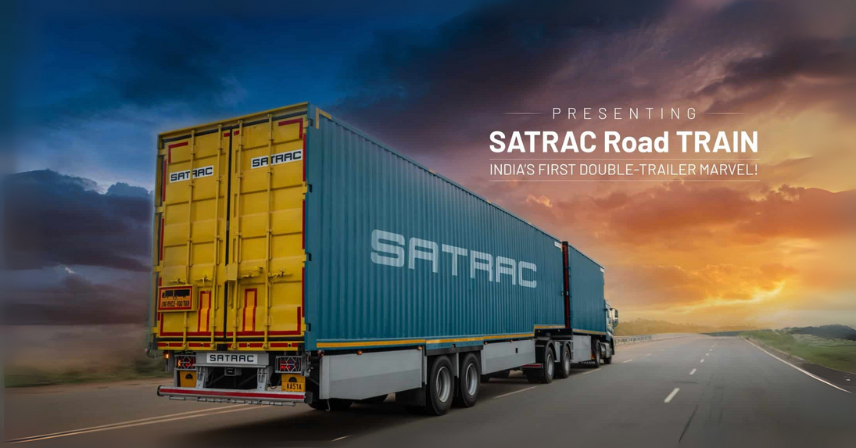Discover how SATRAC Road Train is transforming Indian logistics with higher efficiency, cost savings, and sustainable transport solutions for the future.
India’s logistics sector is the backbone of its economy, ensuring smooth transportation of goods across vast distances. With rising demands in e-commerce, manufacturing, and infrastructure, there’s a pressing need for cost-efficient, high-capacity, and sustainable transport solutions. Enter the SATRAC Road Train—a game-changing innovation designed to redefine road logistics in India.
This advanced transportation solution promises higher payloads, reduced operational costs, and improved efficiency, making it a potential catalyst for the future of Indian logistics.
What is a SATRAC Road Train?
A road train refers to a trucking configuration where one truck (prime mover) hauls multiple trailers, connected through special couplings. Popular in countries like Australia, road trains are known for their long-haul efficiency.
SATRAC, a leading trailer manufacturer in India, has now introduced this innovative model for Indian roads. The SATRAC Road Train is built to handle heavy-duty transport requirements, optimized for local road conditions while complying with government norms.
Why India Needs Road Trains
1. Growing Logistics Demand
India’s logistics market is expected to touch $380 billion by 2030, with rising demand for faster and more efficient goods movement. Traditional trucking faces challenges like:
- Limited load capacity
- High fuel costs
- Driver shortages
- Time delays
2. Cost Efficiency
By pulling two or more trailers in one go, the SATRAC Road Train significantly reduces fuel costs per tonne of cargo transported, making it cost-effective for businesses.
3. Sustainability
Fewer trucks on the road mean lower emissions per tonne-km, aligning with India’s sustainability goals.
Key Features of SATRAC Road Train
- High Payload Capacity
- Each road train can haul up to twice the load of conventional trucks.
- Reduced trips mean faster turnaround.
- Each road train can haul up to twice the load of conventional trucks.
- Advanced Trailer Design
- SATRAC uses durable materials and cutting-edge engineering to withstand heavy loads.
- SATRAC uses durable materials and cutting-edge engineering to withstand heavy loads.
- Improved Safety Mechanisms
- Equipped with anti-lock braking systems (ABS), stability controls, and better coupling safety.
- Equipped with anti-lock braking systems (ABS), stability controls, and better coupling safety.
- Fuel Efficiency
- Optimized aerodynamics and multi-trailer efficiency reduce fuel consumption by up to 20%.
- Optimized aerodynamics and multi-trailer efficiency reduce fuel consumption by up to 20%.
- Driver-Friendly Operations
- Better cabin ergonomics, GPS-enabled systems, and reduced fatigue due to fewer trips.
Advantages of SATRAC Road Train for Indian Logistics
1. Boosts Productivity
Businesses can move larger consignments in fewer trips, improving efficiency.
2. Reduces Transportation Costs
Lower fuel, toll, and maintenance costs per tonne of goods make it economically attractive.
3. Enhances Long-Distance Freight Movement
Perfect for ports, mining, and industrial corridors where bulk cargo needs to be moved efficiently.
4. Decongests Highways
Instead of multiple trucks carrying smaller loads, fewer road trains mean less traffic congestion.
5. Supports E-Commerce & Manufacturing Growth
As online shopping and industrial production rise, logistics demand will surge—road trains are the ideal solution.
Challenges in Adopting Road Trains in India
While the SATRAC Road Train is promising, it comes with challenges:
- Road Infrastructure: Many Indian highways are not designed for such long vehicles.
- Regulatory Approvals: Road train operations require special permissions and safety checks.
- Driver Training: Handling multi-trailer vehicles needs specialized training.
- Urban Access: Road trains are better suited for highways than congested city roads.
Despite these hurdles, gradual integration along industrial corridors and highways will ensure smoother adoption.
SATRAC Road Train vs Conventional Trucks
| Feature | SATRAC Road Train | Conventional Trucks |
| Payload Capacity | 2X or more | Standard load |
| Fuel Efficiency | 20% better | Average |
| Trips Required | Fewer | More |
| Cost Per Tonne-Km | Lower | Higher |
| Environmental Impact | Reduced emissions | Higher emissions |
| Road Space Utilization | Efficient | Less efficient |
Impact on Indian Economy
- Reduced Logistics Cost – India’s logistics cost is around 14% of GDP, higher than global averages (8–10%). SATRAC Road Trains can bring this down.
- Faster Supply Chains – Helps in quick deliveries for industries like steel, cement, and agriculture.
- Job Creation – New roles in manufacturing, maintenance, and specialized driving.
Global Competitiveness – Efficient logistics improve India’s Ease of Doing Business ranking.
Future of Road Trains in India
- Integration with Smart Logistics Hubs: Dedicated freight corridors and logistic parks will support road train movement.
- Electrification & Sustainability: Future versions may include electric or hybrid road trains, reducing carbon footprints further.
- Digital Monitoring: IoT-enabled fleet management will make operations smarter and safer.
With government initiatives like Gati Shakti Yojana and private investments in logistics, SATRAC Road Train is set to play a major role in India’s transport transformation.
Conclusion
The SATRAC Road Train marks a significant leap forward in Indian logistics. By offering greater payloads, cost efficiency, and sustainability, it has the potential to reshape the way goods move across the nation. While infrastructure and regulatory hurdles remain, the long-term benefits are undeniable.
As India strives to become a global logistics hub, innovations like SATRAC’s road train will be at the forefront of this transformation.
👉 For more updates like this, visit www.carbikebhp.com

